Beneficial
none known
Family: Scarabaeidae Subfamily: Scarabaeinae Genus: Copris Species: Copris remotus Leconte, 1866
none available
Total body length 10.0–16.0 mm (0.39–0.63 in). Body shape oval; may be caked in dung. Color shiny black. Clypealclypeal:
of, or referring to, the clypeus
apexapex:
point or edge furthest from the body
notched. Fronsfrons:
part of the head generally positioned between the eyes (posterior to the clypeus and anterior to the vertex) and visible dorsally
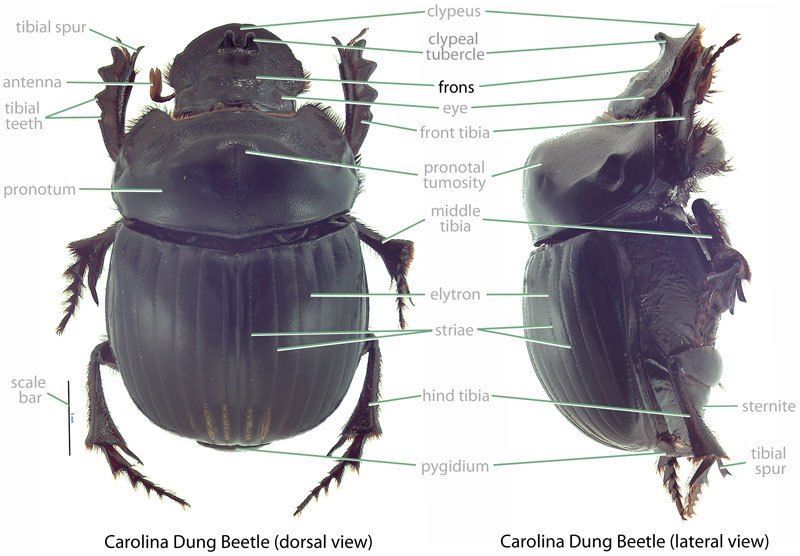 of major male with long, thin, well-developed horn; horn reduced in minor males; horn truncatetruncate:
of major male with long, thin, well-developed horn; horn reduced in minor males; horn truncatetruncate:
appearing cut-off or suddenly shortened
to lacking in females. Pronotumpronotum:
the dorsal surface of the thorax
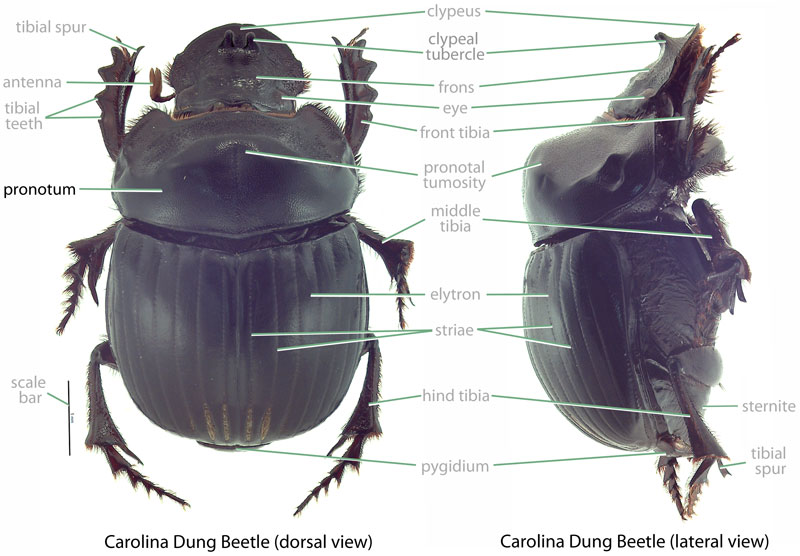 with four horn-like protuberances in males; protuberances much reduced in females. ElytraElytra:
with four horn-like protuberances in males; protuberances much reduced in females. ElytraElytra:
the hardened and chitinous wing-cover of a beetle that protect and overlie the flight wing
with 9 striae; 8th striastria:
a longitudinal depressed line or furrow, often formed from numerous punctures that extends the length of an elytron
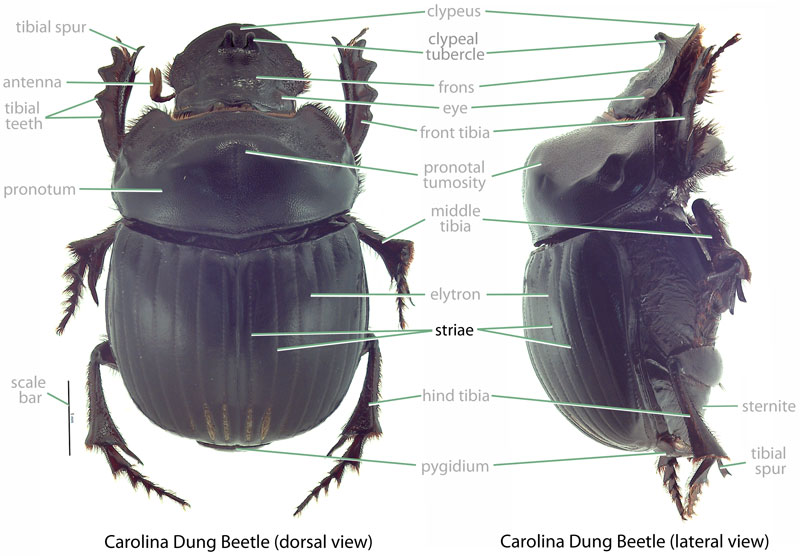 complete, reaching rear margin of elytraelytra:
complete, reaching rear margin of elytraelytra:
the hardened and chitinous wing-cover of a beetle that protect and overlie the flight wing
.
Undescribed. For Copris spp. (Ritcher, 1966Ritcher, 1966:
Ritcher P. 1966. White grubs and their allies: a study of North American scarabaeoid larvae. Oregon State University Monographs, Studies in Entomology 4: 1-219.): Grub C-shaped, hump-backed, cylindrical, whitish. Maxillamaxilla:
set of paired mouthparts located posterior to the mandibles
with galeagalea:
outer branch or lobe of the maxilla
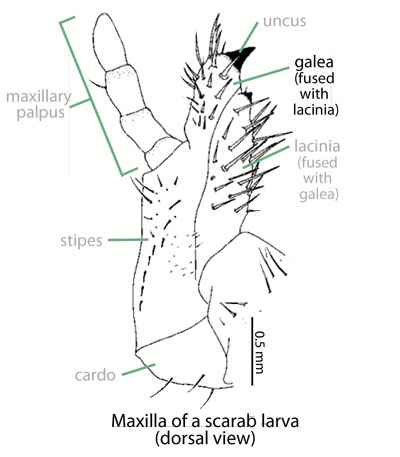 and lacinialacinia:
and lacinialacinia:
inner portion of the maxilla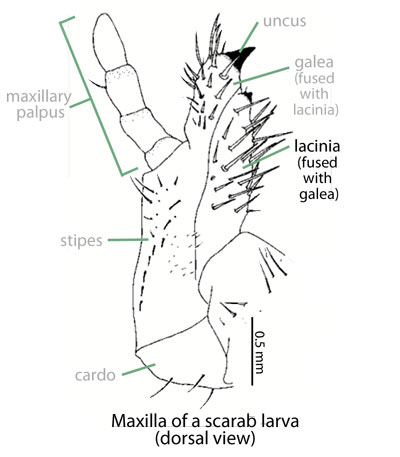 distinctly separated. Epipharynxepipharynx:
distinctly separated. Epipharynxepipharynx:
lobe on the interior surface of the labrum or clypeus
with tormaetormae:
in scarab larvae, sclerotized structures on the ends of the clypeolateral suture extending towards the mesal line
united mesallymesally:
at or near midline of body
, anterioranterior:
the front or forward; opposite of posterior
phoba present. Antennaantenna:
paired sensory organ on head, formed from numerous segments
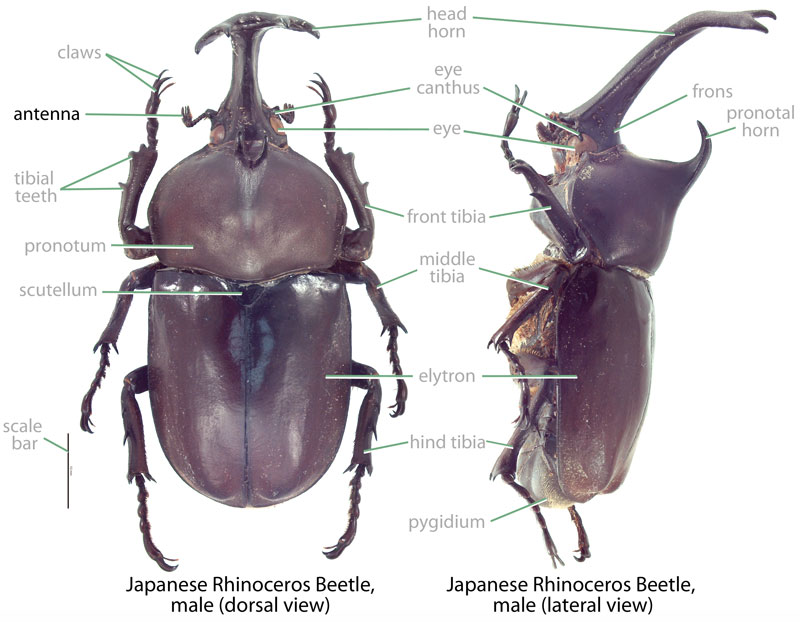 4-segmented; distaldistal:
4-segmented; distaldistal:
situated away from the point of articulation, thus usually furthest from the body
segment much reduced in size. Legs with small, blunt claws each bearing a terminal setaseta:
small, hair-like structure
. Prothoracic shieldprothoracic shield:
the chitinous plate behind the head of larvae
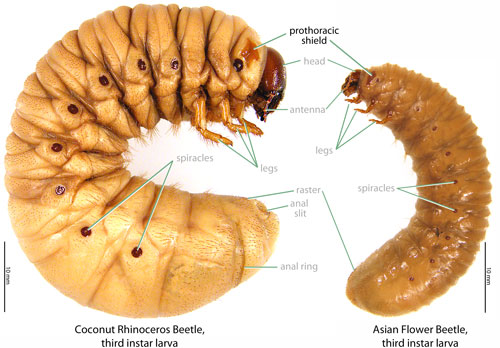 with an anteriorly projecting, angular process on each side. Venter of last abdominal segment with pairedpaired:
with an anteriorly projecting, angular process on each side. Venter of last abdominal segment with pairedpaired:
in relation to bilateral symmetry: occurring on both sides of the body
, median, caudalcaudal:
oriented towards the posterior
lobes or a cleft median lobe.
Southwestern U.S., northern Mexico. In the U.S., this species is known from Texas and Oklahoma. In Mexico, the species is recorded from Coahuila, Nuevo León, and Tamaulipas (Kohlmann et al., 2003Kohlmann et al., 2003:
Kohlmann B, Cano E, Delgado L. 2003. New species and records of Copris (Coleoptera: Scarabaeidae; Scarabaeinae) from Central America. Zootaxa 167: 1-16. full text (accessed 2015)).
None. This species feeds on dung as both an adult and larvalarva:
the immature form of an insect; in scarabs, also called grub or white grub; preceded by the egg stage, followed by the pupal stage
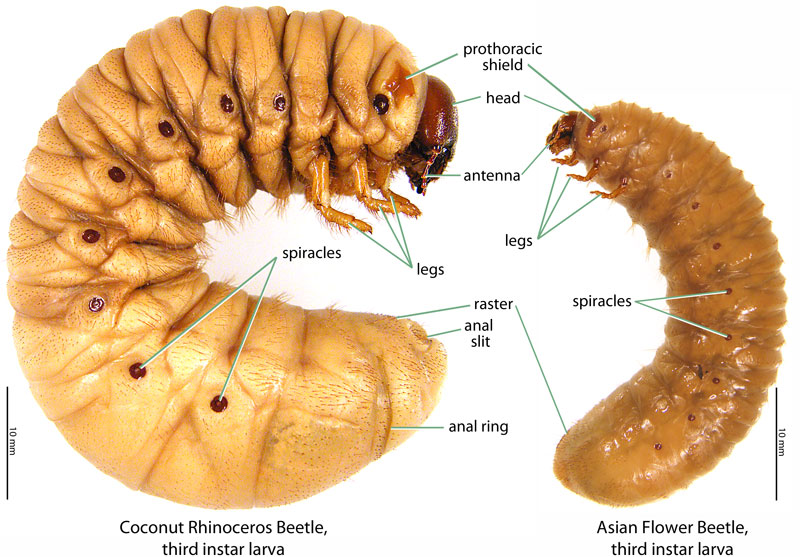 . There are no records of Copris remotus feeding on live plant tissues.
. There are no records of Copris remotus feeding on live plant tissues.
(Woodruff, 1973Woodruff, 1973:
Woodruff R. 1973. The scarab beetles of Florida (Coleoptera: Scarabaeidae) part I. The Laparosticti (Subfamilies: Scarabaeinae, Aphodiinae, Hybosorinae, Ochodaeinae, Geotrupinae, Acanthocerinae). Arthropods of Florida and Neighboring Land Areas 8: 1-220.): Although the life history of this species is poorly known, related Copris species are dung tunnelers, with a male and female creating a burrow under a dung source. The burrow is provisioned with dung, which is formed into pear-shaped brood balls. An egg is deposited within each brood ball. Brood balls are attended by the female during development of the larvalarva:
the immature form of an insect; in scarabs, also called grub or white grub; preceded by the egg stage, followed by the pupal stage
 (Ratcliffe and Paulsen, 2008Ratcliffe and Paulsen, 2008:
(Ratcliffe and Paulsen, 2008Ratcliffe and Paulsen, 2008:
Ratcliffe B and Paulsen P. 2008. The scarabaeoid beetles of Nebraska (Coleoptera: Scarabaeoidea). Bulletin of the University of Nebraska 22: 138-248.).
None. This species recycles dung and is beneficial for ranching and farming in Hawaii. Primarily being a dung feeder, this species has never been recorded damaging crop or ornamental plants. Additionally, this species is not a threat to native dung beetles because none occur in Hawaii or Guam.
Recorded, not established. In Hawaii, this species was imported in 1921 to combat the horn fly (Haematobia irritans), a biting pest of livestock (Fullaway, 1921Fullaway, 1921:
Fullaway O. 1921. Horn fly control. The Hawaiian Forester and Agriculturist: Quarterly Magazine of Forestry, Entomology, Plant Inspection and Animal Industry 18: 219-221. full text (accessed 2015)). Specimens were released on all major islands except Kauai (Hawaii Division of Forestry, 1923Hawaii Division of Forestry, 1923:
Anonymous. 1923. Report of the entomologist. Hawaii Board of Commissioners of Agriculture and Forestry. Division of Forestry. Honolulu, HI: Hawaiian Gazette Company.). Despite these efforts the species failed to establish in Hawaii (Nishida, 2002Nishida, 2002:
Nishida G (editor). 2002. Hawaiian terrestrial arthropod checklist, fourth edition. Bishop Museum Technical Report 22: 1-313.).
Not established or recorded. There are no records of this species from Guam.
In Hawaii, this species was intentionally imported.
This scarab is extremely similar to the closely related Copris incertus. These species are separated by examination of the elytraelytra:
the hardened and chitinous wing-cover of a beetle that protect and overlie the flight wing
(Copris remotus with the 8th striastria:
a longitudinal depressed line or furrow, often formed from numerous punctures that extends the length of an elytron
 complete, reaching the posteriorposterior:
complete, reaching the posteriorposterior:
towards the rear end; opposite of anterior
elytral margin versus C. incertus with 8th striastria:
a longitudinal depressed line or furrow, often formed from numerous punctures that extends the length of an elytron
 incomplete, not reaching the posteriorposterior:
incomplete, not reaching the posteriorposterior:
towards the rear end; opposite of anterior
elytral margin).
Copris remotus dicyrtus Matthews and Halffter
Report your observation of this beneficial species at our iNaturalist project.